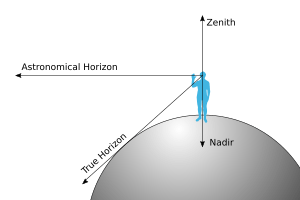Nadir facts for kids

In astronomy, the nadir is a special point that means "below" a specific location. Imagine you are standing somewhere; the nadir is the direction straight down, following the pull of gravity. It's the exact opposite of the zenith, which is the point directly "above" you. The nadir isn't a physical object you can touch. Instead, it's a reference point used to help astronomers and scientists describe where other things are located in space.
Contents
What is the Nadir?
The nadir is a key concept in understanding how we describe positions in space. It helps us define directions from any point on Earth or even in space. Think of it as a line going from your feet, straight through the Earth, and out the other side.
Nadir and Gravity
The direction of the nadir is always aligned with the force of gravity. This means if you drop something, it falls towards the nadir. Because gravity pulls towards the center of the Earth, the nadir for someone standing on the surface points towards the Earth's core.
Nadir vs. Zenith
The nadir and the zenith are two opposite points. If the zenith is the point directly above your head, the nadir is the point directly below your feet. These two points are always 180 degrees apart from each other. They are important for setting up coordinate systems that help us map the sky and space.
Why is the Nadir Important?
Scientists and engineers use the nadir for many reasons. It helps them understand how satellites orbit Earth and how telescopes are aimed.
Using Nadir in Space
When we talk about satellites, "nadir-pointing" means the satellite's cameras or sensors are always looking straight down at the Earth. This is very useful for weather satellites, Earth observation satellites, and spy satellites that need to see what's happening on the surface below.
Nadir in Everyday Life
While you might not use the word "nadir" every day, the concept is all around you. When you stand upright, your body is aligned with the direction of gravity, pointing towards the nadir. It's a fundamental part of how we understand our position relative to the Earth.
Related pages
See also
 In Spanish: Nadir para niños
In Spanish: Nadir para niños

